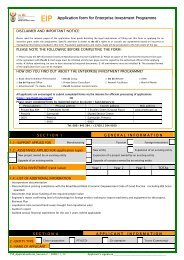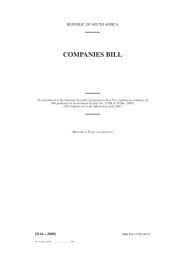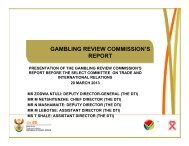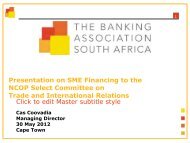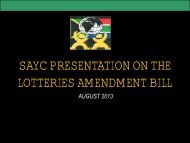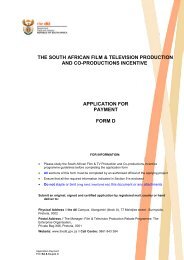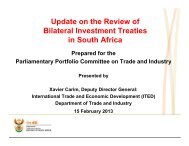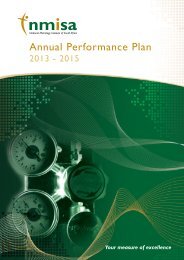Copyright Review Commission Report - ICT Law and Regulation ...
Copyright Review Commission Report - ICT Law and Regulation ...
Copyright Review Commission Report - ICT Law and Regulation ...
- No tags were found...
Create successful ePaper yourself
Turn your PDF publications into a flip-book with our unique Google optimized e-Paper software.
the final rate or rates to be applied. If the amount for the arrears differed from that computed in terms of theTribunal's determination, there would be either a partial refund by RiSA or an extra payment by the SABC.Despite the fact that the SABC's representatives confirmed that the two agreements were not linked, it appearsthat the SABC's refusal to implement the undertaking it gave to the CRC in respect of the arrears is based onRiSA's refusal to accept the SABC's proposals based on future use <strong>and</strong> its insistence on extra terms, which theSABC does not find acceptable.3.2.23. The CRC hopes it is not too late for the parties to resume negotiations on the issues outst<strong>and</strong>ing <strong>and</strong> resolvethem satisfactorily.3.3 LESSONS TO BE LEARNED FROM EVENTS SINCE THE ENACTMENT OFNEEDLETIME LEGISLATION3.3.1. The fact that nine years after the enactment of the needletime legislation, not a cent has been paid to thosewhose sound recordings have been broadcast shows that the provisions in the <strong>Copyright</strong> Act <strong>and</strong> Performers'Protection Act dealing therewith, as well as the Collecting Societies <strong>Regulation</strong>s, are defective <strong>and</strong> requireamendment.3.3.2. Section 9A (1) (a) of the <strong>Copyright</strong> Act <strong>and</strong> Sub-sections (1) (b) <strong>and</strong> (3) of Section 5 of the Performers' ProtectionAct put in place a statutory licence for those who intend to perform the acts referred to in Section 9 (c), (d) <strong>and</strong>(e) of the <strong>Copyright</strong> Act without the permission of the rights holders. Unlike the legal rules relating to rightsenjoyed, for example, by composers, which from a jurisprudential point of view can be described as ‘propertyrules’, the rules relating to the use of rights (Section 9 (c)-(e)) subject to the payment of royalties in terms ofSection 9(A(1)(a)) of the Act can be described as ‘liability rules’. ‘Property rules’ describe how an owner ofproperty may control the use of his or her property by a stranger, subject to the power of the <strong>Copyright</strong> Tribunal,under Section 33 (3) <strong>and</strong> (5) of the <strong>Copyright</strong> Act, to overrule a refusal by an owner to give permission for the useof the property or the grant of permission on unreasonable terms (in which case the permission is granted by theTribunal <strong>and</strong> must exist before the stranger uses the property). ‘Liability rules’ permit a stranger to use the rightswithout the owner's permission, but subject to the incurrence on the user's part of liability to pay the owner of theright a royalty, to be quantified by agreement with the owner of the right or determined by the <strong>Copyright</strong> Tribunalor an arbitrator. The distinction between property <strong>and</strong> liability rules was expounded by Guido Calabresi <strong>and</strong> ADouglas Melamed in “Property Rules, Liability Rules <strong>and</strong> Inalienability, One View of the Cathedral”, 85 Harvard<strong>Law</strong> <strong>Review</strong> 1089 (1972). The statutory licence in respect of needletime does not adequately protect the positionof the holders of the rights to which the licence relates, <strong>and</strong> this lack of protection led directly to the unsatisfactorysituation outlined above. (In this respect, it differs markedly from the corresponding provisions in the British<strong>Copyright</strong>, Designs <strong>and</strong> Patents Act, 1988, as amended, on which many of the recommendations set out beloware based.)3.3.3. The Act simply requires the statutory licensee (the user) to pay a royalty when agreed or determined, withoutspecifying that the agreement or determination is to exist before the use, giving rise to the liability to pay theroyalty. If there is no agreement as to the royalty <strong>and</strong> no reference to arbitration, a reference to the <strong>Copyright</strong>Tribunal could take a long time before being finalised. The Tribunal's decision may be taken on appeal to a fullBench in the High Court <strong>and</strong> even to the Supreme Court of Appeal if the necessary leaves to appeal are granted,all of which could lead to further delays. This puts the performer in an even worse position. The performer does- 24 -



